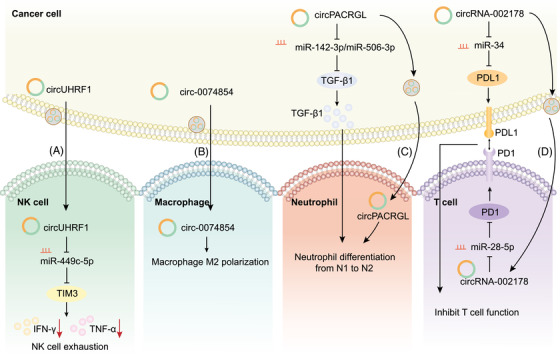FIGURE 6.

Molecular mechanisms of exosomal circular RNAs (circRNAs) in antitumour immunity; exosomal circRNAs reprogram the biological behaviours of various immune cells. (A) Exosomal circUHRF1 derived from cancer cells is delivered to natural killer (NK) cells to elicit NK cell exhaustion through the miR‐449c‐5p/TIM3 pathway. (B) Exosomal circ‐0074854 derived from cancer cells is delivered to macrophages to induce protumourigenic M2 polarization. (C) CircPACRGL not only increases transforming growth factor‐β1 (TGF‐β1) secretion through the miR‐142‐3p/miR‐506‐3p/TGF‐β1 pathway in cancer cells, but is also delivered to neutrophils through exosomes, collaboratively promoting the differentiation of neutrophils to the protumourigenic N2 phenotype. (D) CircRNA‐002178 not only promotes PDL1 expression in cancer cells by sponging miR‐34, but is also delivered to T cells through exosomes and promotes PD‐1 expression in T cells by sponging miR‐28‐5p. The elevated expression of PD1 and PDL1 inhibits T‐cell function and facilitates tumour immune evasion
